pixelSplat
3D Gaussian Splats from Image Pairs for Scalable Generalizable 3D Reconstruction (CVPR 2024)
pixelSplat - 3D Gaussian Splats from Image Pairs for Scalable Generalizable 3D Reconstruction (CVPR 2024)
David Charatan, Sizhe Li, Andrea Tagliasacchi, Vincent Sitzmann
paper :
https://arxiv.org/abs/2312.12337
project website :
https://davidcharatan.com/pixelsplat/
code :
https://github.com/dcharatan/pixelsplat
reference :
NeRF and 3DGS Study
Abstract
- pixelSplat :
reconstruct a 3DGS primitive-based parameterization of 3D radiance field from only two images
Introduction
- Problem :
-
scale ambiguity:
camera pose has arbitrary scale factor -
local minima:
primitive param.을 random initialization으로부터 직접 optimize하면 local minima 문제 발생
-
- Contribution :
- two-view image encoder :
two-view Epipolar Sampling, Epipolar Attention덕분에
scale ambiguity 문제 극복 - pixel-aligned Gaussian param. prediction module :
depth를sampling하기 때문에
local minima 문제 극복
- two-view image encoder :
- Solution :
- feed-forward model 이, a pair of images로부터,
3DGS primitives로 parameterized되는 3D radiance field recon.을 학습
- feed-forward model 이, a pair of images로부터,
- model :
-
per-scene model:
각각의 scene을 학습하기 위해정해진 하나의 points set을iterativelyupdate
\(\rightarrow\)
local minima 등 문제 있어서
3DGS에서는 non-differentiable Adaptive Density Control 기법으로 해결하려 하지만
이는 일반화 불가능 -
feed-forward model:
scene마다 얻은 points set을한 번에 feed-forward로 넣어서 학습
differentiable하게 일반화 가능- attention
- MASt3R(-SfM), Spann3R, Splatt3R, DUSt3R (잘 모름. 더 서치해봐야 함.)
-
Background
- local minima :
- 언제 발생? :
random location에 initialize된 Gaussian primitives가
최종 목적지까지 a few std보다 더많이 움직여야 될 때
gradient가 vanish 되어버려서
또는
최종 목적지까지 loss가 monotonically decrease하지 않을 때
local minima 발생 - 해결법? :
3DGS에서는
non-differentiable pruning and splitting 기법인
Adaptive Density Control을 사용하지만
본 논문에서는
differentiableparameterization of Gaussian primitives 소개
- 언제 발생? :
Scale Ambiguity
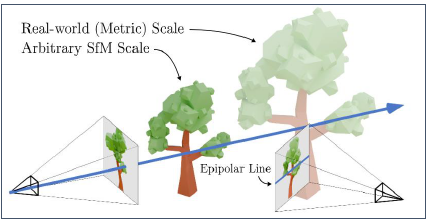
- Scale Ambiguity 문제 :
-
SfM 단계에서 camera pose를 계산할 때
real-world-scale pose \(T_{j}^{m}\) 을
metric pose \(s_{i} T_{j}^{m}\) 으로 scale하여 사용- \(s_{i}\) :
arbitrary scale factor - metric pose \(s_{i} T_{j}^{m}\) :
real-world-scale pose의 translation component를 \(s_{i}\) 만큼 scale
- \(s_{i}\) :
- single image의 camera pose \(s_{i} T_{j}^{m}\) 로부터
arbitrary scale factor \(s_{i}\) 를 복원하는 건 불가능
-
- Scale Ambiguity 해결 :
- two-view encoder에서
a pair of images로부터
arbitrary scale factor \(s_{i}\) 복원
- two-view encoder에서
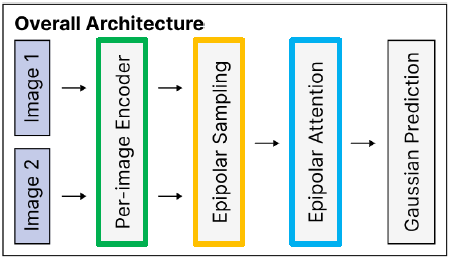
- Two-view encoder Overview :
- Step 1) Per-Image Encoder
- Step 2) Epipolar Sampling
- Step 3) Epipolar Attention
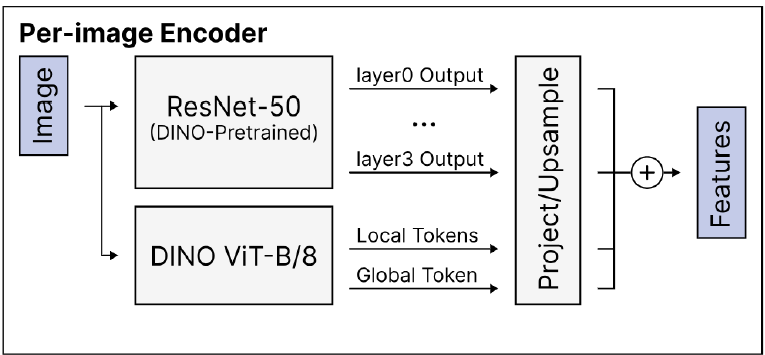
Step 1) Per-Image Encoder
- Step 1)
Per-Image Encoder:
each view (two images)를 각각 feature \(F\), \(\tilde F\) 로 encode
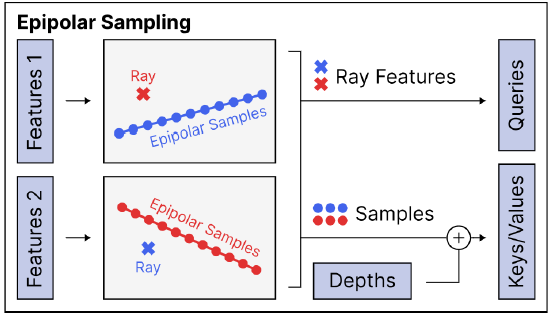
Step 2) Epipolar Sampling
- Step 2)
Epipolar Sampling:
Features 1 from Image 1의ray로query만들고,
Features 2 from Image 2의epipolar samples및depth로key, value만들어서,
attention으로 depth scale을 잘 학습하는 게 목적
(attention : depth 정보와 함께, Image 1의 ray가 Image 2의 epipolar line 위 어떤 sample에 더 많이 attention하는지)
(epipolar line은 학습하는 게 아니라 수학 식으로 계산)- Query :
\(q = Q \cdot F [u]\)
where \(F\) : Features 1 from Image 1
where \(F [u]\) : ray feature at each pixel (in pixel coordinate) - Key, Value :
\(s = \tilde F [\tilde u_{l}] \oplus \gamma (\tilde d_{\tilde u_{l}})\)
where \(\tilde F\) : Features 2 from Image 2
where \(\tilde F [\tilde u_{l}]\) : samples on epipolar line
where \(\tilde d_{\tilde u_{l}}\) : Image 2의 camera 원점까지의 거리- \[k_{l} = K \cdot s\]
- \[v_{l} = V \cdot s\]
- Query :
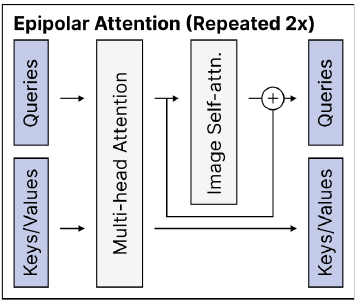
Step 3) Epipolar Attention 중 Epipolar Cross-Attention
- Step 3) Epipolar Attention :
-
Epipolar Cross-Attention:
앞서 만든 \(q, k_{l}, v_{l}\) 로cross-attention 수행하여
per-pixelcorrepondence b.w. ray and epipolar sample찾음으로써
per-pixel feature \(F [u]\) 가 이제
arbitrary scale factor \(s\) 에 consistent한
scaled depth를 encode하도록 update- \(F [u] += Att(q, k_{l}, v_{l})\)
where \(+=\) : skip-connection
where \(Att\) : softmax attention
- \(F [u] += Att(q, k_{l}, v_{l})\)
-
Per-Image Self-Attention:
Cross-Attention 끝난 뒤 마지막에 Per-Image Self-Attention 수행하여
propagate scaled depth estimates
to parts of the image feature maps
that may not have any epipolar correspondences- \[F += SelfAttention(F)\]
-

Gaussian Parameter Prediction
- 앞선 과정들 덕분에
scale-aware feature map \(F, \tilde F\) 를 이용하여
Gaussian param. \(g_{k} = (\mu_{k}, \Sigma_{k}, \alpha_{k}, S_{k})\) 를 예측- 2D image 상의
모든 각 pixel은 3D 상의 point에 대응되어
최종적인 Gaussian primitives set은
just union of each image
- 2D image 상의
- 3D position Prediction :
- 방법 1) Baseline :
predict point estimate of 3D position \(\mu\)- \(\boldsymbol \mu = \boldsymbol o + d_{u} \boldsymbol d\)
where \(u\) : 2D pixel coordiante
where \(\boldsymbol d = R K^{-1} [u, 1]^{T}\) : ray direction
where \(d_{u} = g_{\theta}(F [u])\) : depth obtained by neural network - 문제 :
depth 자체를 neural network로 추정하는 건 local minima 문제 발생하기 쉬움
- \(\boldsymbol \mu = \boldsymbol o + d_{u} \boldsymbol d\)
- 방법 2) 본 논문 방식 :
predictprobability densityof 3D position \(\mu\)- 핵심 :
neural network로
depth 자체를 예측하는 게 아니라
differentiable probability distribution of likelihood of depth along ray를 예측 - Step 1)
depth를 \(Z\)-bins로 discretize
\(b_{z} = ((1 - \frac{z}{Z})(\frac{1}{d_{near}} - \frac{1}{d_{far}}) + \frac{1}{d_{far}})^{-1} \in [d_{near}, d_{far}]\)
for \(z \in [0, Z]\) : depth index - Step 2)
discrete probability \(\phi\) 로부터 index \(z\) 를 sampling
\(z \sim p_{\phi}(z)\) - Step 3)
ray를 쏴서(unproject) Gaussian mean \(\mu\) 계산
\(\boldsymbol \mu = \boldsymbol o + (b_{z} + \delta_{z}) \boldsymbol d\)
where \(\phi\) : depth(\(z\)) probability obtained by neural network
where \(\delta_{z}\) : depth offset obtained by neural network
- 핵심 :
- 방법 1) Baseline :
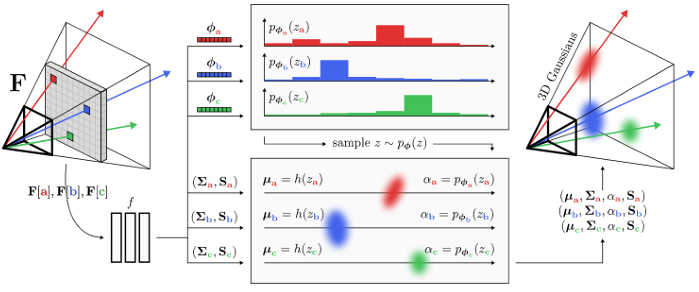
- Gaussian Parameter Prediction :
- scale-aware feature map \(F, \tilde F\) 과 neural network \(f\) 를 이용하여
\(\phi, \delta, \Sigma, S = f(F [u])\)
where \(\phi, \delta, \Sigma, S\) : depth probability, depth offset, covariance, spherical harmonics coeff.-
3D position(mean) :
\(\phi, \delta\) 이용해서
\(\boldsymbol \mu = \boldsymbol o + (b_{z} + \delta_{z}) \boldsymbol d\) -
Covariance:
\(\Sigma\) -
Spherical Harmonics Coeff.:
\(S\) -
Opacity:
\(\phi\) 이용해서
\(\alpha = \phi_{z}\)
\(=\) probability of sampled depth \(z\)
(so that we make sampling differentiable)
-
- 각 pixel마다 3DGS point에 대응되므로
pixel-aligned Gaussians라고 부름
- scale-aware feature map \(F, \tilde F\) 과 neural network \(f\) 를 이용하여
Experiments
- Setup :
- Dataset :
camera pose is computed by SfM- RealEstate 10k
- ACID
- Baseline :
- pixelNeRF
- GPNR
- Method of Du et al.
- Metric :
- PSNR
- SSIM
- LPIPS
- Dataset :

- Result :
- performance much better
- inference time faster
- less memory per ray
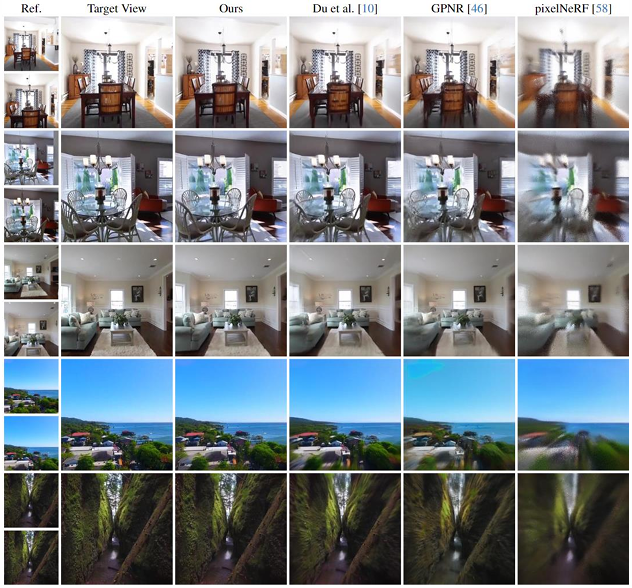
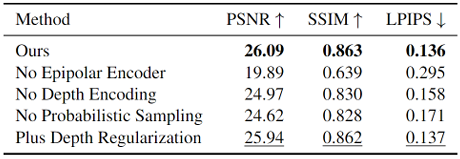
Ablation Study
- Ablation Study :
- Epipolar Encoder : Epipolar Sampling and Epipolar Attention
- Depth Encoding : freq.-based positional encoding \(\gamma(\tilde d_{\tilde u_{l}})\)
- Probabilistic Sampling : depth index \(z \sim p_{\phi}(z)\)
- Depth Regularization :
???